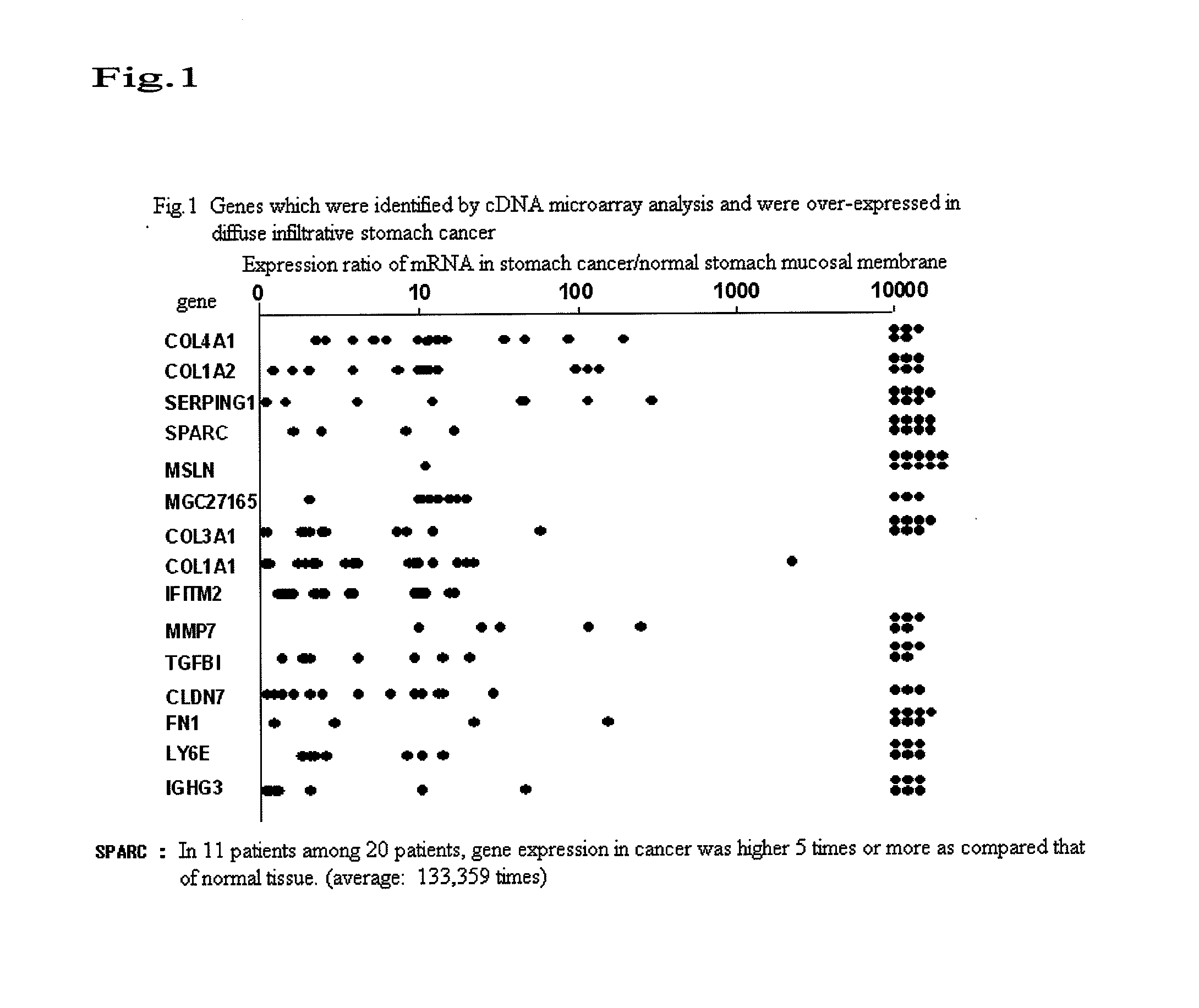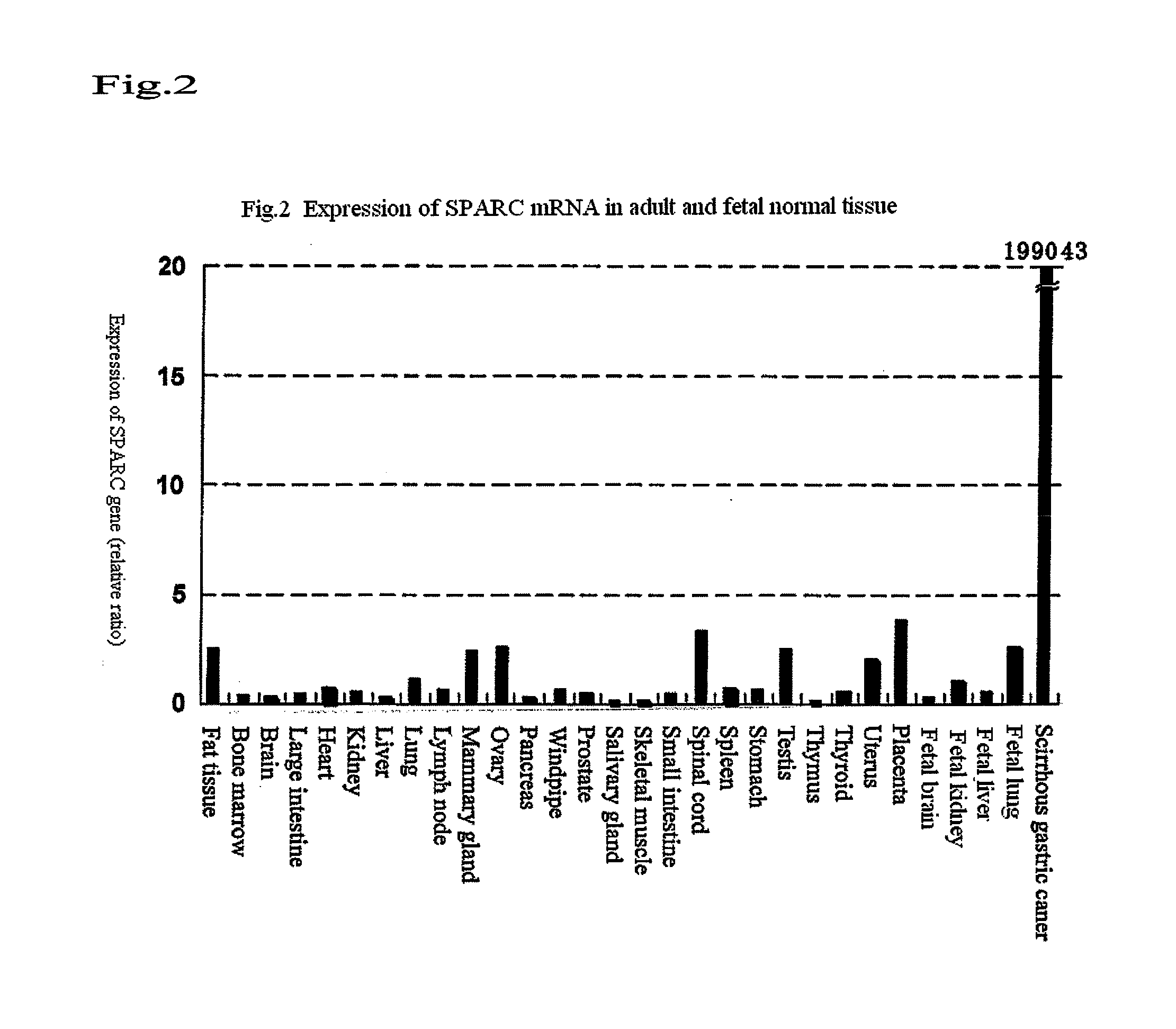Sparc-derived tumor rejection antigenic peptides and medicaments comprising the same
a tumor and antigen technology, applied in the field of tumor rejection antigen peptides and medicaments comprising the same, can solve the problems of poor prognosis, stomach cancer remains stomach cancer is still a main cause of death, so as to improve the immunity of patients suffering, alleviate the symptoms of stomach cancer, and induce a strong immune response
- Summary
- Abstract
- Description
- Claims
- Application Information
AI Technical Summary
Benefits of technology
Problems solved by technology
Method used
Image
Examples
example 1
[0071](1) cDNA Microarray Analysis
[0072]With regard to the excised cancerous tissue of a patient with diffuse infiltrative stomach cancer, a cancerous tissue was distinguished from non-cancerous tissues by Laser capture microdissection, and both the cancerous and non-cancerous portions were then cut out. Thereafter, RNA was extracted from each tissue. When cDNA was synthesized from such RNA by a reverse transcription reaction, cDNA generated from cancerous tissue was fluorescently labeled with Cy5, and cDNA generated from non-cancerous tissue was fluorescently labeled with Cy3. Subsequently, the two cDNA preparations were mixed to obtain target DNA. Hybridization was carried out on a slide glass on which probe cDNA had been arrayed, and non-specific bonds were then eliminated by washing. Thereafter, fluorescence images obtained after the hybridization were captured using a CCD camera or a fluorescence scanner, and they were then displayed with false colors (Cy5: red; Cy3: green). At...
example 2
(2) Selection of Human HLA-A24- and Mouse Kd-Restricted SPARC Peptide Repertoires
[0074]In human and mouse SPARC having a homology of 95%, the following peptides were selected from the fragment of SPARC of which amino acid sequences were shared between humans and mice. The total amino acid sequences of SPARC molecules were searched based on known information regarding amino acid sequences commonly observed in peptides having strong binding affinity to both human HLA-A24 and mouse Kd molecules. The repertoires of peptides that were assumed to have high binding affinity for the two types of molecules were selected by using a computer program. As a result, 4 types of peptides were selected as candidate peptides (Table 1).
TABLE 1SPARC-derived peptides possibly havingbinding affinity to both human HLA-A24and mouse Kd moleculesStartBinding scorePeptideSequencepositionA24KdSPARC- Kd-1DYIGPCKYI14375400SPARC- Kd-2HFFATKCTL123201382 SPARC- Kd-3EFPLRMRDWL16130960SPARC- Kd-4MYIFPVHWQF225210 120P...
example 3
[0084](5) Induction of Antitumor Immunity in BALB / c Mice by Immunization with SPARC Peptide
(Method)
[0085]BM-DC was cultured with a mixture of SPARC Kd-1, 3 and 4 peptides (10 μM for each) for 2 hours. Thereafter, 5×105 cells were intraperitoneally administered to each mouse. After an interval of 1 week, a peptide-loaded BM-DC was administered to the mouse in the same manner, so that the mouse was immunized two times in total. Seven days later, a mouse fibrosarcoma cell line, Meth A (1×106 cells), which highly express mouse SPARC, was subcutaneously transplanted to the mouse. Thus, the growth of the tumor and the survival time of the mouse were examined.
(Results)
[0086]The results are shown in FIG. 4. Preventive administration of SPARC peptide pulsed BM-DC could induced inhibition of the growth of the subcutaneously transplanted Meth A and induced a prolongation of the survival time of the mouse.
PUM
 Login to View More
Login to View More Abstract
Description
Claims
Application Information
 Login to View More
Login to View More - R&D
- Intellectual Property
- Life Sciences
- Materials
- Tech Scout
- Unparalleled Data Quality
- Higher Quality Content
- 60% Fewer Hallucinations
Browse by: Latest US Patents, China's latest patents, Technical Efficacy Thesaurus, Application Domain, Technology Topic, Popular Technical Reports.
© 2025 PatSnap. All rights reserved.Legal|Privacy policy|Modern Slavery Act Transparency Statement|Sitemap|About US| Contact US: help@patsnap.com



